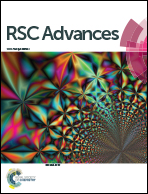Improving the interfacial properties of carbon fibers/vinyl ester composites by vinyl functionalization on the carbon fiber surface
Abstract
A novel “coupling agent” N-(4-amino-phenyl)-2-methyl-acrylamide (APMA) was synthesized to efficiently enhance interfacial interactions between the carbon fiber (CFs) and vinyl ester resin (VE). Fourier transform infrared spectroscopy (FT-IR) and X-ray photoelectron spectroscopy (XPS) were employed to characterize functional groups and chemical compositions of a carbon fiber surface, which indicated that the vinyl groups of APMA were grafted successfully on the surface of the CFs. Four different treatments of CFs (pristine CFs, carboxylic-CFs, acrylamide-CFs and APMA-CFs) were used to prepare the CF-reinforced VE composites. The mechanical properties were analysed and a micro-droplet test was performed to investigate the enhancement effect of the coupling agent on the interfacial strength of the composites. Scanning electron microscopy (SEM) showed that APMA-CFs were uniformly distributed throughout the matrix, and no open ring holes were found at the cross-section of the composites; furthermore, after micro-droplet test, some matrix was still attached to the debonded CF surface. As a result, APMA functionalized CFs improved the flexural strength of the APMA-CF/VE composites by 19.4%, and significantly improved the interfacial shear strength between APMA-CFs and VE by 90.53%.


 Please wait while we load your content...
Please wait while we load your content...